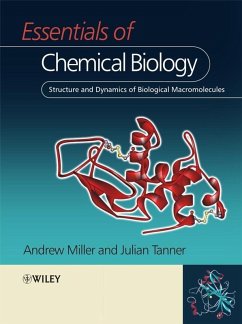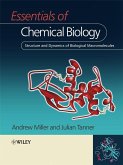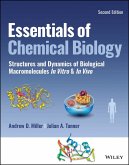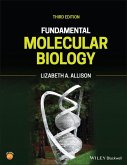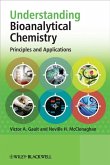"This excellent work fills the need for an upper-level graduate course resource that examines the latest biochemical, biophysical, and molecular biological methods for analyzing the structures and physical properties of biomolecules... This reviewer showed [the book] to several of his senior graduate students, and they unanimously gave the book rave reviews. Summing Up: Highly recommended..." CHOICE Chemical biology is a rapidly developing branch of chemistry, which sets out to understand the way biology works at the molecular level. Fundamental to chemical biology is a detailed understanding of the syntheses, structures and behaviours of biological macromolecules and macromolecular lipid assemblies that together represent the primary constituents of all cells and all organisms. The subject area of chemical biology bridges many different disciplines and is fast becoming an integral part of academic and commercial research. This textbook is designed specifically as a key teaching resource for chemical biology that is intended to build on foundations lain down by introductory physical and organic chemistry courses. This book is an invaluable text for advanced undergraduates taking biological, bioorganic, organic and structural chemistry courses. It is also of interest to biochemists and molecular biologists, as well as professionals within the medical and pharmaceutical industry. Key Features: * A comprehensive introduction to this dynamic area of chemistry, which will equip chemists for the task of understanding and studying the underlying principles behind the functioning of biological macro molecules, macromolecular lipid assemblies and cells. * Covers many basic concepts and ideas associated with the study of the interface between chemistry and biology. * Includes pedagogical features such as: key examples, glossary of equations, further reading and links to websites. * Clearly written and richly illustrated in full colour.
Dieser Download kann aus rechtlichen Gründen nur mit Rechnungsadresse in A, B, BG, CY, CZ, D, DK, EW, E, FIN, F, GR, HR, H, IRL, I, LT, L, LR, M, NL, PL, P, R, S, SLO, SK ausgeliefert werden.
"This excellent work fills the need for an upper-level graduate course resource that examines the latest biochemical, biophysical, and molecular biological methods for analyzing the structures and physical properties of biomolecules. Miller (Imperial College London, UK) and Tanner (Univ. of Hong Kong) cover traditional subjects such as binding interactions and catalysis. They also describe biophysical theories and current methods for protein structure determinations such as circular dichroism, X-ray crystallography, neutron diffraction, NMR, EPR, fluorescence, mass spectrometry, and electron and atomic force microscopy. For example, the chapter on solution NMR provides simplified yet high-quality explanations of the key principles of NMR. The well-developed introduction helps students to better follow the more complex information concerning the principles of multidimensional NMR. In addition, the latter part of the chapter offers current applications using a variety of multidimensional NMR spectroscopy experiments in the analysis of proteins, nucleic acid, carbohydrate, and lipid structures. This reviewer showed Essentials of Chemical Biology to several of his senior graduate students, and they unanimously gave the book rave reviews. The work could be improved by better referencing the resource materials within the text and by providing student exercises at the end of each chapter. Summing Up: Highly recommended. Collections serving graduate students, researchers/faculty, and professionals." -- J. M. Tomich, Kansas State University (Choice, February 2009)
"Essentials in Chemical Biology is a valuable resource not only for chemistry students who are venturing into and interested in biological systems, but also biochemistry and biology students who want a fundamental understanding of the physical and chemical basis of biology and the techniques used in its study." (Chemistry World, August 2009)
"The succinct and lucid presentation style of Essentials Of Chemical Biology will likely make it a popular resource for undergraduate and graduate students interested in the structure and interaction of biologically relevant macromolecules." (Journal of Chemical Biology, February 2009)
"This excellent work fills the need for an upper-level graduate course resource that examines the latest biochemical, biophysical, and molecular biological methods for analyzing the structures and physical properties of biomolecules. Miller (Imperial College London, UK) and Tanner (Univ. of Hong Kong) cover traditional subjects such as binding interactions and catalysis. They also describe biophysical theories and current methods for protein structure determinations such as circular dichroism, X-ray crystallography, neutron diffraction, NMR, EPR, fluorescence, mass spectrometry, and electron and atomic force microscopy. For example, the chapter on solution NMR provides simplified yet high-quality explanations of the key principles of NMR. The well-developed introduction helps students to better follow the more complex information concerning the principles of multidimensional NMR. In addition, the latter part of the chapter offers current applications using a variety of multidimensional NMR spectroscopy experiments in the analysis of proteins, nucleic acid, carbohydrate, and lipid structures. This reviewer showed Essentials of Chemical Biology to several of his senior graduate students, and they unanimously gave the book rave reviews. The work could be improved by better referencing the resource materials within the text and by providing student exercises at the end of each chapter." (J. M. Tomich, Kansas State University, Choice, February 2009)
"The succinct and lucid presentation style of Essentials Of Chemical Biology will likely make it a popular resource for undergraduate and graduate students interested in the structure and interaction of biologically relevant macromolecules." (Journal of Chemical Biology, February 2009)
"This excellent work fills the need for an upper-level graduate course resource that examines the latest biochemical, biophysical, and molecular biological methods for analyzing the structures and physical properties of biomolecules. Miller (Imperial College London, UK) and Tanner (Univ. of Hong Kong) cover traditional subjects such as binding interactions and catalysis. They also describe biophysical theories and current methods for protein structure determinations such as circular dichroism, X-ray crystallography, neutron diffraction, NMR, EPR, fluorescence, mass spectrometry, and electron and atomic force microscopy. For example, the chapter on solution NMR provides simplified yet high-quality explanations of the key principles of NMR. The well-developed introduction helps students to better follow the more complex information concerning the principles of multidimensional NMR. In addition, the latter part of the chapter offers current applications using a variety of multidimensional NMR spectroscopy experiments in the analysis of proteins, nucleic acid, carbohydrate, and lipid structures. This reviewer showed Essentials of Chemical Biology to several of his senior graduate students, and they unanimously gave the book rave reviews. The work could be improved by better referencing the resource materials within the text and by providing student exercises at the end of each chapter." (J. M. Tomich, Kansas State University, Choice, February 2009)

